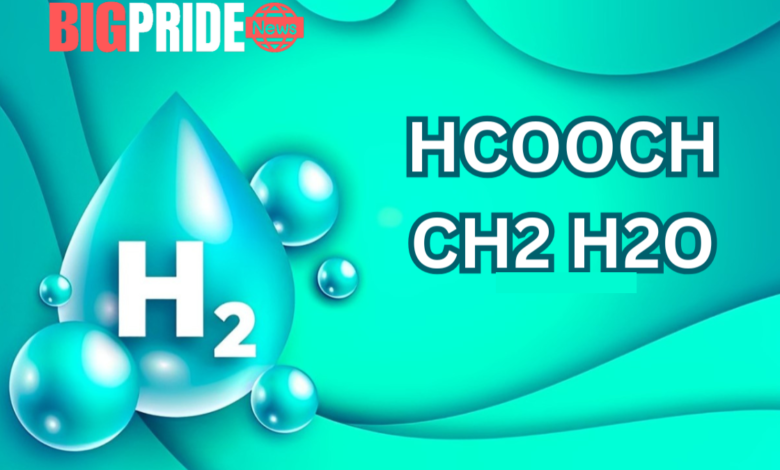HCOOCH CH2 H2O: The Role of This Compound in Organic Chemistry

HCOOCH CH2 H2O, a compound often seen in organic chemistry, plays an essential role in various scientific fields. It is important to understand this compound as it is frequently encountered in chemical reactions, industrial processes, and even pharmaceutical research. The molecular formula HCOOCH CH2 H2O represents a combination of ester (HCOO) and alcohol (CH2OH) groups, with water as an essential part of its composition. This compound’s structure and properties allow it to be involved in a wide range of chemical interactions.
Understanding the chemistry behind HCOOCH CH2 H2O is crucial for anyone working in fields like chemical engineering, biochemistry, and environmental science. Its versatility and reactivity make it a significant topic of study. This article will explore the molecular structure of HCOOCH CH2 H2O, its chemical properties, and its wide array of applications, from industrial processes to environmental and pharmaceutical significance.
As we dive deeper into the structure and functions of HCOOCH CH2 H2O, this article will provide a comprehensive look into how this compound is used and its overall importance. It will also highlight the various reactions it undergoes, the safety protocols for handling it, and its environmental implications.
Chemical Structure and Composition
The chemical formula HCOOCH CH2 H2O can be broken down into three main parts: HCOO (an ester group), CH2OH (a hydroxymethyl group), and H2O (water). Each part of this compound is responsible for its unique chemical behavior and potential uses.
The ester group (HCOO) is formed by the combination of an alcohol and an acid, and it is a key component in the production of numerous organic compounds. The ester linkage allows HCOOCH CH2 H2O to be involved in reactions like hydrolysis and esterification, making it a valuable compound for synthetic chemistry. The CH2OH group represents an alcohol, which is typically involved in hydrogen bonding and other types of interactions with different molecules, making it important in biochemical processes.
The presence of water (H2O) in the formula introduces another dimension to the compound’s reactivity. Water plays a crucial role in hydrolysis reactions, where esters break down in the presence of water, releasing the alcohol and the corresponding acid. This feature is commonly utilized in laboratory settings and industrial applications where ester hydrolysis is required for product synthesis.
In addition to these basic components, the overall molecular structure determines how HCOOCH CH2 H2O interacts with other substances. Its ability to undergo esterification or hydrolysis reactions makes it a versatile compound in various sectors, including research and industry. The molecular bonds and functional groups give HCOOCH CH2 H2O its unique properties, which we will discuss further in the following sections.
Key Properties of HCOOCH CH2 H2O
Physical Properties
The physical properties of HCOOCH CH2 H2O are directly related to the molecular structure of the compound. This compound, being a combination of ester and alcohol groups, exhibits moderate volatility. The boiling point of esters tends to be higher than that of simple alcohols or acids, so HCOOCH CH2 H2O will typically have a moderate boiling point compared to other organic compounds. It is also soluble in both organic solvents and water, which adds to its versatility in chemical synthesis.
When it comes to appearance, this compound is usually colorless or slightly yellow, and its physical state at room temperature can range from a liquid to a solid, depending on the specific structure and molecular weight of the ester involved. As with many esters, it has a characteristic pleasant odor, making it recognizable in both laboratory and industrial settings.
Chemical Properties
HCOOCH CH2 H2O displays a variety of chemical properties due to the presence of both ester and alcohol groups in its structure. It is reactive and often undergoes esterification and hydrolysis reactions. Esterification occurs when an alcohol reacts with an acid, often under the influence of heat or a catalyst, to form an ester and water as byproducts. Conversely, hydrolysis is the reverse reaction, where an ester breaks down into its parent alcohol and acid when exposed to water.
These reactions are pivotal in synthetic organic chemistry, where the control of such reactions allows for the production of various compounds, from plastics to pharmaceuticals. In addition, the alcohol group (CH2OH) makes it capable of hydrogen bonding with water molecules and other compounds, increasing its reactivity and facilitating various biochemical processes.
Applications of HCOOCH CH2 H2O
Industrial Applications
One of the key applications of HCOOCH CH2 H2O is in the chemical industry, where it is used for producing various organic chemicals. Its ability to undergo esterification reactions makes it an essential part of the production of esters and other organic solvents. These solvents are used in the manufacture of paints, adhesives, coatings, and other products in industries such as textiles, automotive, and construction. In addition, HCOOCH CH2 H2O is involved in the production of biodegradable plastics, which are becoming increasingly important as industries move toward sustainable and eco-friendly alternatives.
In chemical synthesis, HCOOCH CH2 H2O is also used as a reactant in producing other compounds, including those used in fragrances, flavorings, and cleaning products. Its versatility as an intermediate compound makes it indispensable in many large-scale industrial processes.
Pharmaceutical and Biochemical Relevance
In the pharmaceutical industry, HCOOCH CH2 H2O plays a role in drug formulation and synthesis. The compound is used in the production of various medications, particularly those that involve ester bonds, such as certain antibiotics and anti-inflammatory drugs. Additionally, the ability of HCOOCH CH2 H2O to undergo hydrolysis allows it to be involved in the design of prodrugs, which are inactive compounds that become active once they are metabolized in the body.
In biochemistry, HCOOCH CH2 H2O is often used in research to study enzyme reactions and metabolic processes. Its reactivity makes it useful in biochemical assays, where it can serve as a substrate for enzyme catalysis, or as a model compound to simulate biological reactions.
Environmental Impact
Although HCOOCH CH2 H2O has numerous industrial and pharmaceutical applications, its environmental impact is a concern, particularly when it is not disposed of properly. Like many esters, it can break down into potentially harmful byproducts in the environment if released in large quantities. However, HCOOCH CH2 H2O is relatively biodegradable compared to other more persistent organic compounds, which makes it somewhat less harmful to the ecosystem. Efforts to manage its waste products include improved recycling processes and stricter waste disposal guidelines.
Reactions Involving HCOOCH CH2 H2O
Esterification and Hydrolysis
HCOOCH CH2 H2O is commonly involved in two important chemical reactions: esterification and hydrolysis. Esterification is a reaction where an alcohol and an acid combine to form an ester. This reaction is frequently catalyzed by either heat or a chemical catalyst, such as sulfuric acid. In the case of HCOOCH CH2 H2O, esterification may involve a carboxylic acid reacting with methanol or ethanol.
Hydrolysis, on the other hand, is the reverse reaction, where the ester bond is broken by the addition of water, resulting in the formation of an alcohol and an acid. This reaction is essential in various biological systems and industrial processes, particularly in the production of surfactants, detergents, and other products that require hydrolyzed compounds.
Catalysis and Organic Synthesis
The ability of HCOOCH CH2 H2O to act as both a reactant and a catalyst in organic synthesis is another key feature. This compound is used in catalytic reactions that facilitate the formation of complex organic molecules. It plays a vital role in the creation of new chemical structures in pharmaceutical and industrial chemistry.
Conclusion
In conclusion, HCOOCH CH2 H2O is a versatile compound with a wide range of applications in both industry and science. Its chemical properties, particularly its ability to undergo esterification and hydrolysis reactions, make it valuable in various fields, from pharmaceuticals to environmental science. Its role in organic synthesis and catalysis underscores its importance in chemical engineering and research.
As industries move toward more sustainable practices and as new methods of chemical synthesis are developed, compounds like HCOOCH CH2 H2O will continue to play a crucial role in shaping future innovations. Understanding its structure, properties, and reactions is essential for professionals working in chemistry, biochemistry, and related fields.
Also Read: vmovee

